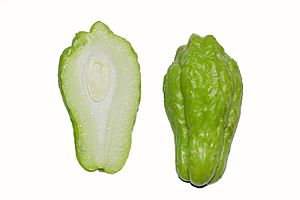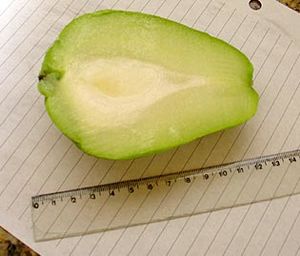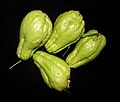Chayote facts for kids
Quick facts for kids Chayote |
|
|---|---|
 |
|
| Chayote fruit | |
 |
|
| Chayote fruit cut lengthwise | |
| Scientific classification | |
| Genus: |
Sechium
|
| Species: |
edule
|
| Synonyms | |
| Nutritional value per 100 g (3.5 oz) | |
|---|---|
| Energy | 80 kJ (19 kcal) |
|
4.51 g
|
|
| Sugars | 1.66 g |
| Dietary fiber | 1.7 g |
|
0.13 g
|
|
|
Protein
|
0.82 g
|
| Vitamins | Quantity
%DV†
|
| Thiamine (B1) |
2%
0.025 mg |
| Riboflavin (B2) |
2%
0.029 mg |
| Niacin (B3) |
3%
0.47 mg |
| Pantothenic acid (B5) |
5%
0.249 mg |
| Vitamin B6 |
6%
0.076 mg |
| Folate (B9) |
23%
93 μg |
| Vitamin C |
9%
7.7 mg |
| Vitamin E |
1%
0.12 mg |
| Vitamin K |
4%
4.1 μg |
| Minerals | Quantity
%DV†
|
| Calcium |
2%
17 mg |
| Iron |
3%
0.34 mg |
| Magnesium |
3%
12 mg |
| Phosphorus |
3%
18 mg |
| Potassium |
4%
125 mg |
| Zinc |
8%
0.74 mg |
|
Link to USDA Database entry
|
|
| †Percentages estimated using US recommendations for adults. | |
The chayote (Sechium edule) is a special edible plant that belongs to the gourd family, just like pumpkins and cucumbers. It's also known by other names like mirliton, pipinola, and choko.
Chayote was first found in Mesoamerica (which is Central America and parts of Mexico). It was one of the many foods that traveled to the Old World (Europe, Asia, Africa) during a time called the Columbian Exchange. This was when new plants, animals, and ideas were shared between the Americas and the Old World. Because of this, chayote became a popular food in many Latin American countries.
Most people eat the chayote fruit cooked. When you cook it, it's often treated like a summer squash. It's usually cooked only a little bit so it stays a bit crunchy. You can also eat raw chayote in salads or salsa. People often marinate it with lemon or lime juice to make it taste better, as it can be a bit tough when raw. Whether you eat it raw or cooked, chayote is a good source of vitamin C, which helps keep you healthy!
Even though the fruit is the most common part to eat, other parts of the plant are also edible. You can eat the root, stem, seeds, and leaves. The tubers (which are like underground stems) can be eaten like potatoes. The young shoots and leaves are often used in salads and stir-fries, especially in Asian cooking.
Contents
What is Chayote Called Around the World?
The common name "chayote" comes from the Spanish word chayote, which itself came from the Nahuatl word chayohtli. Nahuatl was spoken by the Aztec people.
In different parts of the world, chayote has many other names:
- In Louisiana (USA) and Haiti, it's called mirliton.
- In Australia, New Zealand, and Singapore, it's known as choko. This name came from Chinese market gardeners in the 1800s.
- In the eastern Caribbean, it's called christophene.
- In Jamaica, it's chou chou, and in the Dominican Republic, it's tayota.
- In Brazil, it's called chuchu.
- In India and Nepal, it's known as chow chow or ishkush. Sometimes, people just call it squash.
How to Grow Chayote
Chayote plants like to spread out a lot, just like other plants in the gourd family. They need plenty of space to grow. Their roots can rot easily, especially if they are grown in pots.
However, in places like Australia and New Zealand, chayote is quite easy to grow in a yard or garden. People often grow it on a chicken wire support or along a fence. In Trinidad and Tobago, it's grown in mountainous areas, often hanging from wire lines.
What Does Chayote Look Like?
The most common type of chayote fruit is shaped like a pear, but it's a bit flatter and has rough wrinkles. It can be about 10 to 20 centimeters long. It looks like a green pear and has thin, green skin that is connected to its light green or white flesh. Inside, there's one large, flat seed. Some types of chayote even have spiny (prickly) fruits!
The flesh of the chayote has a mild taste. Its texture is often described as a mix between a potato and a cucumber.
The chayote plant is a climbing vine. It can grow on the ground, but it loves to climb onto anything it can find. It can even grow as high as 12 meters if it has something to climb on! The plant has heart-shaped leaves that are about 10–25 centimeters wide. It also has special curly parts called tendrils on its stem that help it climb. The plant produces male flowers in groups and single female flowers. The fruit itself is light green and long, with deep ridges running along its length.
How Chayote is Used in Cooking and Medicine
You don't need to peel the chayote fruit before cooking or frying it in slices. It has a very mild flavor, so it's often served with seasonings like salt, butter, and pepper. It can also be cooked with other vegetables and spices. You can boil it, stuff it, mash it, bake it, fry it, or even pickle it in a special sauce called escabeche. Both the fruit and its seed are full of good things like amino acids and vitamin C.
When choosing chayote, look for firm, fresh green fruits without brown spots or signs of sprouting. Smaller fruits are usually more tender. You can slice chayote lengthwise and eat it with a salad dressing. The seed is also edible and some people enjoy it cold with dressing.
The tuberous (root) part of the plant is starchy and can be eaten like a yam. It can even be used as food for pigs or cattle.
The leaves and fruit of chayote are believed to have special properties. They can help your body get rid of extra water (diuretic), support your heart and blood vessels, and reduce swelling (anti-inflammatory). A tea made from the leaves has been used to help with conditions like hardening of the arteries and high blood pressure. It has also been used to help dissolve kidney stones.
Chayote in the Americas
In Louisiana Creole and Cajun cooking, chayote is a popular dish, especially during holidays like Thanksgiving.
Chayote is a very important part of traditional meals in Mesoamerica. You can find it in many different dishes there.
In Brazil (where it's called chuchu) and other Latin American countries, chayote is sometimes breaded and fried. It's also used cooked in salads, soups, stews, and soufflés.
In the Eastern Caribbean, the fruit is known as christophene. In Jamaica and other parts of the Western Caribbean, it's called chocho.
Chayote in Asia

In Korea, chayote is called "차요테" and is often served as a side dish. It can be pickled with vinegar and soy sauce or marinated and dressed with sauces and spices to make a salad.
In the Philippines, the plant is called sayote. It's mostly grown in the mountains. Chayote is used in many dishes like soup, stir-fried vegetables, and chop suey. It was brought to the Philippines through the Manila galleon trade, which was a trading route across the Pacific Ocean.
In Indonesia, chayotes are called labu siam. They are widely grown for their young shoots and fruit. They are often used in Sundanese food as lalap (raw vegetables) and are an ingredient in a Sundanese soup called sayur asem.
In Timor-Leste, chayote is called Lakeru Japones. People think it might have been brought there by Japanese soldiers during World War II.
In Burma/Myanmar, chayote is known as "Gurkha Thee" or "Gurkha fruit." It's a popular and affordable vegetable there.
In China, chayote is known as "Buddha's palm" (Chinese: 佛手瓜). It's often stir-fried. In Taiwan and southern mainland China, chayotes are widely grown for their young shoots, which are called lóngxūcài (Chinese: 龙须菜, meaning "dragon-whisker vegetable"). These shoots, along with the young leaves, are commonly eaten vegetables in the region.
In Thai cuisine, chayote is called sayongte (Thai: ซายองเต้) or fak maeo (Thai: ฟักแม้ว, meaning "Miao melon"). It mostly grows in the mountains of northern Thailand. The young shoots and greens are often stir-fried or used in soups.
In eastern and north eastern India and Nepal, the plant and fruit are called squash or ishkus (इस्कुस in Nepali). Its shoots, fruit, and roots are widely used to make different kinds of curries.
In the Indian state of West Bengal, it's generally known as Squash (স্কোয়াশ). The whole vegetable is used to make curries or is sauteed. It's also cooked with fish, eggs, or mutton. People eat a lot of it during the summer and rainy season because it contains a lot of water and is a good source of vitamin C. The young branches can also be used to make dishes like saag. There are two types: dark green and light green. The dark green one is usually more tender.
In Tamil Nadu, South India, chayote is known as Maerakkai (மேரக்காய்) or chow-chow (சௌ சௌ). It's widely used in daily cooking for recipes like sambar, kootu, poriyal, thuvayal, chutney, and mor-kulambu.
In Karnataka, South India, chayote is popularly called seeme badanekaayi (ಸೀಮೆ ಬದನೇಕಾಯಿ) in Kannada, which means "Bangalore brinjal." It's used in vegetable stews like sambar and palya.
In Réunion, an island in the Indian Ocean, chou chou is served in many dishes, especially in the highlands. A popular dish is Chou chou au Gratin (baked with a cheese sauce). It can be a side dish with a meal or even a dessert.
In Mauritius, it's called sousou and is grown in the island's high areas. Mixed with beef, pork, or chicken, chou chou is used to make delicious steamed Chinese dumplings called niouk yen (boulette chou chou) or chow mai. The stems and leaves are used in broth to go with rice and other dishes. Chou chou is also eaten as a pickle, salad, gratin, curry, and stir-fried with beef, egg, or chicken.
Interesting Stories About Chayote
The "Apple Pie" Legend
In Australia, there's a long-standing urban legend that McDonald's apple pies were actually made from chokos (chayotes), not apples. This story became so popular that McDonald's had to make it clear that they use real apples in their pies!
This legend might have started because people used to believe that canned pears were often secretly chayotes. One reason for the rumor is that some recipes in Australia suggest using chayotes to replace part of the canned apples when making apple pies. This probably happened during tough times like the Depression Era and after World War II, when there were shortages of canned fruit. Also, apples don't grow well in many tropical parts of Australia, making them expensive. Chayotes, on the other hand, grow very easily all over Australia, and you can often see chayote vines growing in people's backyards.
The "Mummy" Legend
There's a modern legend that chayote might have helped preserve the bodies of people from the Colombian town of San Bernardo. These people ate a lot of chayote. It's believed that the fruit's special properties might have helped keep their bodies in a very well-preserved state.
Images for kids
See also
 In Spanish: Chayote para niños
In Spanish: Chayote para niños
















